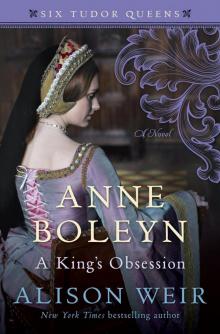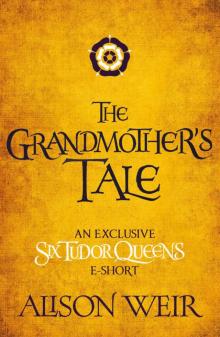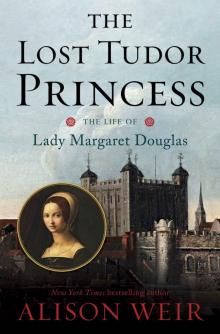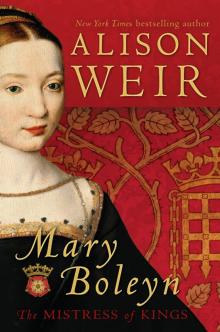- Home
- Alison Weir
Mary, Queen of Scots, and the Murder of Lord Darnley Page 18
Mary, Queen of Scots, and the Murder of Lord Darnley Read online
Page 18
This declaration of innocence on Darnley’s part was not just for his own benefit, but also to protect Mary’s reputation. For, if her husband had not instigated or approved Rizzio’s murder, there would be no grounds for suspecting Rizzio of any impropriety with the Queen. The murder could then be imputed to the jealousy of the Lords, who were to take all the blame for it.
For the sake of her unborn child and her reputation, Mary had protected Darnley from the consequences of his treason, and on the surface it appeared that the two were reconciled; Herries says Mary had told the King she would “forgive and forget all.” But she felt bitterly hurt and alienated by his connivance in what she was convinced had been a plot against her life, and was also contemptuous of the way in which he had betrayed not only herself but also his fellow conspirators. Understandably, she wanted as little to do with him as possible. As most of her courtiers—Lennox and Atholl excepted— were already shunning him, Darnley was virtually isolated.
On 21 March, Randolph reported, incorrectly, that Moray and Argyll had returned to court. “The Lords of this last attempt have written to him [Moray] no longer to forbear for their cause to agree with the Queen, and, seeing that the other [Darnley] hath left both them and him, that he do not further endanger himself for their cause. Lennox remains sick at Dunbar, much offended with his son.” Randolph added that Bothwell had been given, by way of reward, all Maitland’s possessions.34These included the rich lands of Haddington Abbey, which had once been under Hepburn patronage.
Knox, in whose publicly stated opinion Rizzio’s murder was “worthy of all praise,”35 fled on 21 March to Ayrshire,36 where he remained for some time, writing his history of the Reformation in Scotland and beseeching God to “destroy that whore in her whoredom.”37
Elizabeth I could have taken advantage of the situation in Scotland, but she was genuinely horrified and outraged to hear of Rizzio’s murder and the Lords’ treatment of their anointed sovereign. Immediately she sent Melville’s brother Robert north to assure Mary of her support and warn Darnley and Moray that, should they again betray their mistress, they would incur Elizabeth’s wrath. In consequence of this, relations between the two Queens were greatly improved, and they resumed their former friendly correspondence. This had not a little to do with the fact that Elizabeth and her ministers were relieved that Rizzio, whom they had suspected to be a papal agent, had been removed, and that Mary had abandoned her pro-Catholic policy.38
Philip II, to whom Guzman de Silva sent a detailed if not very accurate report on 23 March, was also shocked by the events in Scotland, but must have been astounded to learn that Darnley, who had made such a display of Catholic piety, had allied himself with heretics.
Another who was greatly troubled by news of the murder was Lady Lennox,39who was still in the Tower. Belatedly, Darnley grew fearful that she would be the victim of reprisals in consequence of his conduct, and wrote to Queen Elizabeth to assure her that Lady Lennox had had no knowledge whatsoever of the plot. But Elizabeth refused to accept the letter. She asked the messenger if it were true that Darnley had drawn his dagger in the Queen’s presence and, when told he had not, she commented acidly “that she had not believed it, because all the time he was in this country he had never put his hand to a knife.”40
On 29 March, on Mary’s orders, Morton and over sixty other traitors were outlawed. The Queen informed Charles IX: “We have caused all their possessions to be seized [and are] determined to proceed against them with the utmost vigour. To this end, we are satisfied that the King our husband will act in unison with us.”41The Queen, reported Randolph, “wills that all men who are friends to any of those that were privy to David’s death shall pursue them, to do their uttermost to apprehend them.”
Moray, however, was playing his usual double game. On 27 March, Bedford had reported to Cecil that Moray “desireth Your Honour’s favour” for “his dear friends,” Morton and the other fugitive Lords, who, “for his sake, hath given this adventure.” Ruthven, Randolph had noted earlier, was “very sick, keeping most to his bed.”42According to Nau, Darnley also would have liked to see his former allies pardoned, but dared not speak for them to the Queen, who was implacable towards them; as was Bothwell, who lost his temper when Atholl sued for a pardon for his friend Maitland, whose properties Bothwell now held. On 2 April, Randolph reported that matters had “quieted, but Atholl still travails” for Maitland.43
Darnley, meanwhile, had given “express orders to all state officials and subjects of the kingdom to organise a thorough search and arrest anyone who had been with the murderers, wherever they might be found, and punish them with death, and anyone discovered to have helped them in secret was to receive corporal punishment. To set an example to others, he had four of those found at the site of the murder arrested,”44among them Henry Yair and Thomas Scott. Randolph informed Cecil that the complicity of three of these men was known only to Darnley.45 Yair and Scott were hanged and quartered, the only conspirators to be executed for Rizzio’s murder. The other two, Sir John Mowbray of Barnbougle and William Harlaw, both Lothian Lairds, were reprieved on the scaffold on the orders of the Queen, after Bothwell had petitioned for their lives.46
Darnley, who was more deserving of punishment than any of these wretches, was about to receive his come-uppance. The Lords in exile were furious when they heard of his public declaration of innocence; they were determined to set the record straight and, in the process, have their revenge. On 2 April, Morton and Ruthven sent Cecil their account of the conspiracy,47 and revealed that they had vindictively forwarded to Mary the Bond, in the King’s handwriting, in which Darnley acknowledged himself the chief instigator of the plot to punish Rizzio, in the Queen’s presence if necessary, and undertook to protect his fellow plotters from any repercussions. Any illusions Mary may have retained about her immature husband being easily led astray by wicked men and being entirely innocent of the murder were now dramatically shattered: “so many sighs she would give that it was a pity to hear her.”48Moreover, it was clear that, at best, Darnley had spared no thought for her safety; at worst, he had intended the shock to kill her. He had betrayed her, her unborn child, and the men who had plotted for his advancement. This she could not forgive, and from the time she saw the incriminating Bond, Mary and Darnley were virtually estranged.
After Darnley’s murder, Lennox claimed, with a view to incriminating Mary, that she told Darnley “that she never trusted to die till she might revenge the death of her servant David, and that she feared the time should come that he himself might be in the like case as David was, and ask mercy many a time, when it should be refused unto him.”49Yet in April 1566, Mary could not just order Darnley’s arrest and execution, as his enemies had hoped she would do, nor could she punish him in any public manner, for she dared not jeopardise her child’s right to the succession. Given the rumours that she had had an affair with Rizzio, she needed to maintain a show of solidarity with Darnley and avoid any confrontations until the infant was born and Darnley had acknowledged it as his own. Until then, she resolved to conceal her revulsion and contempt. But there were other, more subtle, ways of punishing a treacherous husband. Darnley found himself excluded, not only from state affairs,50 but from the mainstream life of the court, and constantly watched, in case he should plot some new mischief. The Queen would never trust him again, and the Lords despised him and wanted nothing to do with him. Humiliatingly, it seemed to be public knowledge that his wife would not sleep with him.51 Furthermore, he had to live with the certain knowledge that, if the Queen pardoned his enemies and allowed them to return to Scotland, he would be doomed. Darnley reacted to this treatment by sulking and devising wild ideas of revenge. Even in isolation, he was a danger to Mary’s security.
Security certainly remained a priority, with the political situation so uncertain. Holyrood’s defences had proved easy to breach, so, on 3 April, on the advice of her Council, Mary took up residence in the royal lodging within the stout walls of Edinburgh C
astle, one of the greatest fortresses in Scotland. Darnley went with her, but the nobility, including Bothwell, remained in the town.52 On 15 April, the Council advised the Queen to stay in Edinburgh Castle until after the birth of her child, “to guard against what she had been warned would occur, that the Lords were resolved to take possession of the infant from the moment of its birth.”53
There had been Bronze Age and Roman settlements on the lofty volcanic rock that dominates the city of Edinburgh; a castle certainly existed by the Dark Ages, but the mediaeval fortress was first built by Malcolm III in the late eleventh century. The tiny chapel dedicated to his wife, St. Margaret, dates from this period, and is the oldest surviving building in the castle precincts. Most of the early fortifications were destroyed by Robert the Bruce in the fourteenth century, but his son, David II, erected a great tower modelled on Edward III’s Round Tower at Windsor. The royal lodgings were built in the fifteenth century by James III and James IV on the south-east side of the castle precincts, around what is now called Crown Square; they were renovated in 1566 for Mary and Darnley, whose visit is commemorated by a seventeenth-century carving “MAH 1566” above a doorway in Palace Yard. The Queen’s apartments comprised an impressive great hall with a hammer-beam roof, a presence chamber, an inner chamber that served as a bedchamber, and a tiny cabinet leading off it; these rooms had windows commanding spectacular views to the south, but they had been largely unused for many years because Holyrood had long since become the favoured city residence of the sovereign. Normally, Edinburgh Castle was used to house the Crown Jewels and other treasure, munitions, the national archives, some officers of state and state prisoners. Now a sovereign was in residence again, and the royal chambers were made luxurious with Turkish carpets, oak furniture and damask cushions.54
On 4 April (and again on 25 April), Randolph reported a rumour that Mary, having seen the incriminating bond, was “grievously offended” with Darnley and had sent an envoy, James Thornton, to Rome to inquire about the possibility of an annulment of her marriage.55If true, this must have been on the grounds that the couple, who were within the forbidden degrees of consanguinity, had married before the dispensation had arrived from Rome, but in such circumstances any children of the union would be illegitimate, and it is unlikely that Mary would have contemplated taking such a risk just now. Thornton did leave Edinburgh around this time, but it was to convey letters from Mary to Elizabeth I and Charles IX.56
Randolph also reported that the Queen was “determined the House of Lennox shall be as poor as ever it was.” Lennox himself, still ill and “sore troubled in mind,” had been forbidden the court,57 and now lay at Holyrood, where Darnley had visited him only once.58There is no record of what passed between them. In 1568, Lennox would assert that Mary had entered into an adulterous affair with Bothwell at this time, despite the fact that she was nearly seven months pregnant: he claimed that while Darnley, “that innocent lamb who meant so faithfully unto her as his wife,” had been outcast from her company, “Bothwell waxed so great that he, supplying the place of David, was her love in such sort that she, forgetting her duty to God and her husband, and setting apart her honour and good name, became addicted and wholly assotted unto the said Bothwell.”59
This affair was supposed to have begun soon after Mary moved into Edinburgh Castle. Bothwell was lodged in the town, but had leave to attend on the Queen at certain times, and was a frequent guest at her dinner table, along with Huntly; contrary to what many writers state, there were opportunities for clandestine dalliance. However, there is no contemporary evidence to support Lennox’s allegations, which appear rather ludicrous, given Mary’s heavily pregnant state, and are at variance with Buchanan’s libel of 1568, which claims that Mary became sexually involved with Bothwell in September 1566. Both documents, significantly, were written at a time when it had become politically imperative to demonstrate that Mary was an adulteress and murderess. Furthermore, Darnley never at this time displayed any jealousy of Bothwell, and Bothwell himself, although newly married, was about to embark, had perhaps already embarked, on a liaison with his wife’s sewing maid.
On 4 April, Mary wrote Elizabeth a warm letter of gratitude for her support, asking her not to give succour to the fugitive Lords, and inviting her to stand as godmother to her child.60 Darnley was furious about this, taking it as a personal insult, for Elizabeth had never recognised him as King of Scots, and he hated her. But Mary and her Council refused to listen; they were laying the foundations for her child’s potential future as heir to a united Scotland and England, and needed Elizabeth’s goodwill.
Elizabeth, who was ostentatiously going about with a miniature of Mary hanging from a gold chain around her waist, was still expressing outrage at the way Darnley had behaved to his wife and sovereign. On 11 April, she told de Silva, “Had I been in Queen Mary’s place, I would have taken my husband’s dagger and stabbed him with it!”61 The following month, she ordered the fugitive Lords to leave England.62
Mary was still keeping up the pretence that she and Darnley were reconciled. He was present when the French diplomat, Michel de Castelnau, Sieur de la Mauvissière, arrived in Edinburgh just before Easter, having been sent by the Guises to warn Darnley to behave himself; Darnley also joined the Queen for the Maundy Thursday ceremonies on 12 April.63Yet beneath the surface, tensions were simmering. Drury reported that “the displeasure abates not between the King and Queen, but rather increases.” Days before, Darnley had ridden secretly to Stirling “for the purpose of renewing the conspiracy with Argyll and Moray.”64But the Queen’s spies were vigilant and warned Mary, who sent Robert Melville after the King with a warning not to revive his treachery. It was a fool’s errand anyway, since Moray and Argyll had “such misliking of their King as never was more of man”65and were, in fact, already on their way to Edinburgh, intent on reaching a rapprochement with the Queen.
They arrived at Edinburgh Castle on 21 April.66 Moray told Mary that they had “taken up arms in consequence of the King only, against whom they had acted in their own defence—not against her. They had no share in the interests and indignities offered to the Queen in her own palace, nor with the murder of the late David; for these, Lord Ruthven and his accomplices were entirely responsible.” Mary admitted “she had no private quarrel with Moray: all had come through the King her husband,” and he “was resolved to pardon Moray. The rigour with which she had hitherto acted towards the Earl was chiefly to please her husband,” hence she was “easily induced” to agree to a reconciliation,67 and gave Moray and Argyll permission to stay in Edinburgh Castle with her,68intending to keep a close watch on their doings. Moray’s wise counsel and political support would be an advantage of which she was sorely in need at this time, and his restoration to power would certainly ease relations with England, but she would never fully trust him again.
Neither would Bothwell, Huntly, the Catholic Bishop Leslie and Darnley, who all immediately allied against Moray. Bothwell and Moray had long been bitter enemies—Moray had once told Lady Argyll that Scotland could not hold them both at the same time; Huntly wanted revenge on Moray for ruining his father; and Darnley was terrified of Moray, believing that he and the exiled Lords “would have their revenge on him, as soon as they could.”69 Together, they tried to convince Mary that Moray was as much to blame for the murder as the fugitive Lords, and urged her to lock him up, at least until her child was born, “alleging that they were assuredly advertised that he and his dependers were resolved to bring in the banished Lords, even at the very time of her child-bearing.” But Mary, believing that their accusations arose “only from their own hatred,”70 refused to listen, declaring that she knew Moray to be well disposed towards her and that she had forgiven him his former offences. Furthermore, in order to prevent any confrontations, she barred Bothwell, Huntly and Moray for a short period from her dinner table. She kept Bothwell sweet by confiding to him that, in the Will she would soon be drawing up, she would be appointing him a member of the Counc
il of Regency in the event of her death in childbirth. Darnley was to be expressly excluded.
Darnley was also determined to prevent the return of Maitland. “The King proposed that the office of Secretary should be given to the Bishop of Ross in the place of Lethington, whom he especially charged with having been a principal in the late conspiracy.”71When Mary refused to countenance this, Darnley “became exceedingly angry” and sent one of the grooms of his Chamber to tell the Queen “how much he was displeased with her, and that he had primed and made ready his two pistols, which she would find hanging at the back of the bed.” Fearing that he might try to shoot himself, Mary went to his bedchamber at once and, “after having stayed with him for some time, she quietly carried off the pistols.” Next day, she informed her Council what had happened, “hoping thus to remove from her husband’s mind the prejudice which he had conceived against Lethington, and to let them understand the decision at which she had arrived, which they followed.”72
Darnley’s chief objective now “was to play off, by every means in his power, the one party against the other, so that he himself should become stronger than either of them. The Queen had reason to dread this, knowing as she did the inconstancy and treachery which she had found in his character.”73 It was also obvious that Darnley was blind to reality. On 25 April, Randolph reported that Mary wanted all feuds healed, but that there had been discord between her and Darnley, who was being scorned by the nobles. Moray and Argyll showed only contempt for him, and Melville noticed that the King “passed up and down on his own, and few durst bear him company.”

 Richard III and the Princes in the Tower
Richard III and the Princes in the Tower Britain's Royal Families: The Complete Genealogy
Britain's Royal Families: The Complete Genealogy The Lady in the Tower: The Fall of Anne Boleyn
The Lady in the Tower: The Fall of Anne Boleyn Six Wives of Henry VIII
Six Wives of Henry VIII Elizabeth of York: A Tudor Queen and Her World
Elizabeth of York: A Tudor Queen and Her World Captive Queen
Captive Queen Innocent Traitor
Innocent Traitor The Marriage Game
The Marriage Game A Dangerous Inheritance
A Dangerous Inheritance Katherine of Aragón: The True Queen
Katherine of Aragón: The True Queen The Marriage Game: A Novel of Queen Elizabeth I
The Marriage Game: A Novel of Queen Elizabeth I Princes in the Tower
Princes in the Tower Anne Boleyn: A King's Obsession
Anne Boleyn: A King's Obsession Traitors of the Tower
Traitors of the Tower Mistress of the Monarchy: The Life of Katherine Swynford, Duchess of Lancaster
Mistress of the Monarchy: The Life of Katherine Swynford, Duchess of Lancaster Queens of the Conquest: England’s Medieval Queens
Queens of the Conquest: England’s Medieval Queens Eleanor of Aquitaine: A Life
Eleanor of Aquitaine: A Life Mary, Queen of Scots, and the Murder of Lord Darnley
Mary, Queen of Scots, and the Murder of Lord Darnley Henry VIII: The King and His Court
Henry VIII: The King and His Court Queen Isabella: Treachery, Adultery, and Murder in Medieval England
Queen Isabella: Treachery, Adultery, and Murder in Medieval England Katheryn Howard, the Scandalous Queen
Katheryn Howard, the Scandalous Queen Arthur- Prince of the Roses
Arthur- Prince of the Roses The Wars of the Roses
The Wars of the Roses Eleanor of Aquitaine: By the Wrath of God, Queen of England
Eleanor of Aquitaine: By the Wrath of God, Queen of England Mary Boleyn: The Great and Infamous Whore
Mary Boleyn: The Great and Infamous Whore Jane Seymour: The Haunted Queen
Jane Seymour: The Haunted Queen Anna of Kleve, the Princess in the Portrait
Anna of Kleve, the Princess in the Portrait Lancaster and York: The Wars of the Roses
Lancaster and York: The Wars of the Roses The Grandmother's Tale
The Grandmother's Tale The Princess of Scotland (Six Tudor Queens #5.5)
The Princess of Scotland (Six Tudor Queens #5.5) The Lady Elizabeth
The Lady Elizabeth Katherine Swynford: The Story of John of Gaunt and His Scandalous Duchess
Katherine Swynford: The Story of John of Gaunt and His Scandalous Duchess The Curse of the Hungerfords
The Curse of the Hungerfords The Lost Tudor Princess: The Life of Lady Margaret Douglas
The Lost Tudor Princess: The Life of Lady Margaret Douglas Eleanor of Aquitaine
Eleanor of Aquitaine Mistress of the Monarchy
Mistress of the Monarchy The Lost Tudor Princess
The Lost Tudor Princess Henry VIII
Henry VIII Anne Boleyn, a King's Obsession
Anne Boleyn, a King's Obsession A Dangerous Inheritance: A Novel of Tudor Rivals and the Secret of the Tower
A Dangerous Inheritance: A Novel of Tudor Rivals and the Secret of the Tower Elizabeth of York
Elizabeth of York Katherine of Aragon, the True Queen
Katherine of Aragon, the True Queen Katherine Swynford
Katherine Swynford Wars of the Roses
Wars of the Roses Queens of the Conquest
Queens of the Conquest Mary Boleyn
Mary Boleyn Britain's Royal Families
Britain's Royal Families The Tower Is Full of Ghosts Today
The Tower Is Full of Ghosts Today Life of Elizabeth I
Life of Elizabeth I Anne Boleyn A King's Obssession
Anne Boleyn A King's Obssession Lancaster and York
Lancaster and York Jane Seymour, the Haunted Queen
Jane Seymour, the Haunted Queen Queen Isabella
Queen Isabella The princes in the tower
The princes in the tower